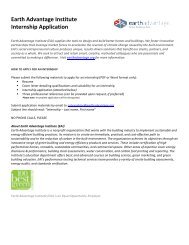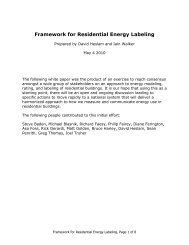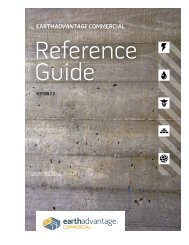EA New Homes Measures Guide - Earth Advantage
EA New Homes Measures Guide - Earth Advantage
EA New Homes Measures Guide - Earth Advantage
Create successful ePaper yourself
Turn your PDF publications into a flip-book with our unique Google optimized e-Paper software.
2012 <strong>Earth</strong> <strong>Advantage</strong> Residential<br />
<strong>Measures</strong> Resource <strong>Guide</strong><br />
3.1.3<br />
Accountability Form: General<br />
Rainscreen Wall System: 3/8" airspace under siding (whole house)<br />
Energy<br />
Materials<br />
Water<br />
0 0 0 2 0<br />
Description: A rainscreen wall is a moisture-management system incorporating exterior cladding, a 3/8-inch air cavity, flashings, a drainage<br />
plane (building paper or housewrap). The cavity is open at the top and bottom for drainage of liquid water and ventilation of water vapor.<br />
Health<br />
Land<br />
Benefit: This technique helps extend the life of the siding, helps paint on the siding to last longer, and helps prevent moisture from<br />
entering the wall cavity. This is accomplished by neutralizing wind-driven rain, offering multi-layered redundancy, and integrating drainage<br />
and ventilation to accelerate cavity moisture removal.<br />
Verification: <strong>EA</strong> Rater will verify the presence of a properly constructed rainscreen. Critical details are at least 3/8-inch air space between<br />
the siding and the drainage plane.<br />
3.1.4<br />
Low-point Drain: Crawl space or basement<br />
Energy<br />
Health Land Materials<br />
Prerequisite<br />
Description: A low point drain removes water that collects in the crawlspace during construction and in the event of a plumbing leak or high<br />
water event. The floor of the crawlspace is graded to one or more low points. Provide a drain at each low point that slopes to daylight or to<br />
a sump pump with a sealed cover. Use a backflow valve to prevent reverse flow of outside water into the crawl space, and to reduce the<br />
chance of vermin entry. Gutter drains and foundation drains must not be connected to the crawl space drain.<br />
Water<br />
Benefit: Standing water in crawlspaces can be a common source of moisture problems in houses. Water vapor rises from the crawlspace<br />
and enters the building. This can lead to structural decay and moisture problems.<br />
Verification: <strong>EA</strong> Rater will identify the presence of the drain and verify that the waste line opens to daylight in a way that provides proper<br />
drainage.<br />
3.1.5<br />
Third-Party Framing Lumber Moisture Test: 19% or lower<br />
Energy<br />
Land Materials<br />
Prerequisite<br />
Description: Have a framing lumber moisture content (MC) test performed by a third-party, such as <strong>Earth</strong> <strong>Advantage</strong>. Moisture content (MC)<br />
of the lumber must be 19 percent or lower.<br />
Health<br />
Water<br />
Benefit: Lumber that is moist (higher than 19 percent moisture content) has a much greater chance that it will foster the growth of mold in<br />
the cavity of the wall after it is covered by drywall and other materials. Moist lumber can shrink slightly as it dries out, potentially causing<br />
cracks in drywall and other materials that have been attached to the framing lumber.<br />
Verification: <strong>EA</strong> Rater or a third-party uses a moisture meter to measure the moisture content (MC) of framing and sheathing lumber. The<br />
most important locations to test are framing members and subfloors around window and door openings, bottom plates, as well as larger<br />
dimension lumber (beams and posts). Builder will be notified if any areas do not meet the requirement of 19%. Testing will be conducted<br />
at five (5) window areas and an additional fifteen (15) random areas within the house.<br />
3.2 Foundation Systems<br />
Page 12 of 70








